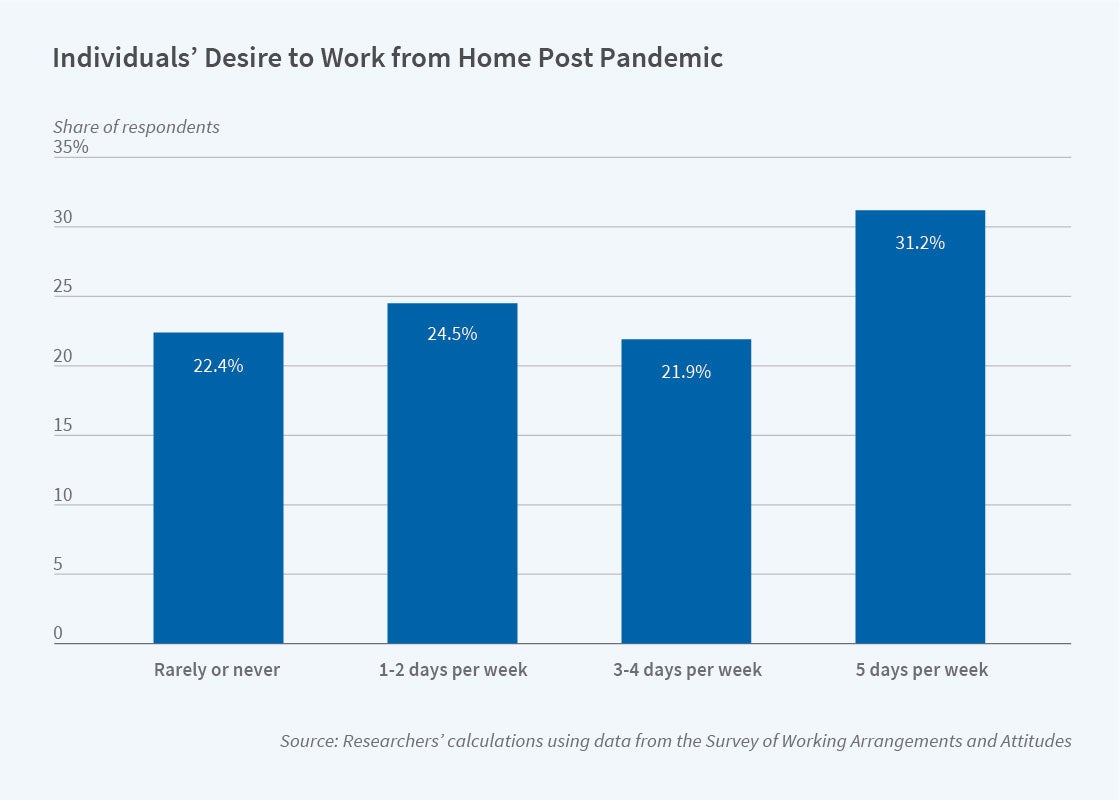Work from Home Likely to Remain Elevated Post Pandemic

Fewer than 30 percent of workers surveyed say they will return fully to pre-COVID activities, while most remain wary of mass transit, crowded elevators, and indoor dining.
After the COVID-19 pandemic ends, 20 percent of all labor in the United States may be satisfied by remote workers, up from 5 percent before the virus struck, according to Why Working from Home Will Stick (NBER Working Paper 28731) by Jose Maria Barrero, Nicholas Bloom, and Steven J. Davis. The researchers estimate that productivity will increase and that spending in city centers will decrease relative to pre-COVID levels.
The findings are based on interviews with major employers and on monthly surveys from May 2020 to March 2021 of persons aged 20–64 who earned at least $20,000 in 2019. Respondents report better-than-expected work-from-home experiences, along with higher productivity.
Workers invested an average of 15 hours of time and $560 to upgrade their home work spaces, equivalent in aggregate terms to an estimated 0.7 percent of annual GDP, the researchers find. Added to that are investments made by employers in cloud computing and other technology to accommodate remote workers. The number of patents for technological innovations to accommodate a home-based workforce more than doubled from January to September 2020. Innovative regulatory policies, such as those allowing a wide range of health workers to work remotely, will also change the post-COVID-19 workplace.
Based on respondents’ self-assessments, the researchers estimate that the hybrid workforce will boost productivity in the post-pandemic economy by 4.6 percent. Most of that gain will come from a reduction in commuting time.
Fewer than 30 percent of respondents say they will return fully to pre-COVID activities; the rest remain wary of mass transit, crowded elevators, and indoor dining. The researchers estimate that the drop in the number of commuters will result in a 5 to 10 percent drop in spending on meals, entertainment, and personal services in major city centers. That spending will be redirected to business establishments closer to workers’ homes.
While workers across all demographic groups express a desire to continue working from home, the highly educated and high earners will have a much greater opportunity to do so. The share of survey respondents who worked from home ranged from 10 percent for those without high school degrees to 50 percent for those with graduate degrees. The share was more than twice as large among those who earned above $150,000 than among those in the $20,000–$50,000 range. Respondents were more likely to work from home if they worked in the service sector, were raising children, and lived in Democratic-leaning states.
The study projects that overall, 20 percent of full workdays will be supplied from home after the pandemic ends. Remote work is feasible for half of the employees, and the typical business plan calls for that half to spend two days — 40 percent — of the work week at home. Business leaders told the researchers that they wanted employees on site at least three days a week for reasons involving motivation, collaboration, and workplace culture.
“For most workers, the post-pandemic economy will entail more WFH [work from home] than in the pre-COVID economy but considerably less than they would like,” the researchers conclude. “The benefits of a persistent shift to WFH will be broadly felt but flow mainly to the better-educated and the highly paid.”
—Steve Maas


